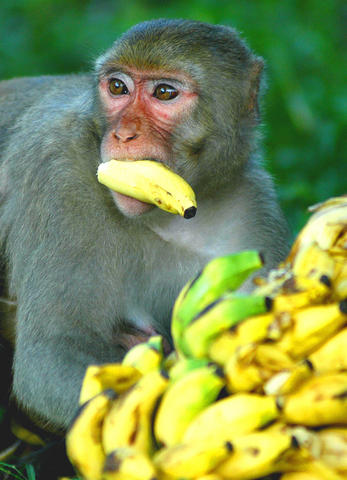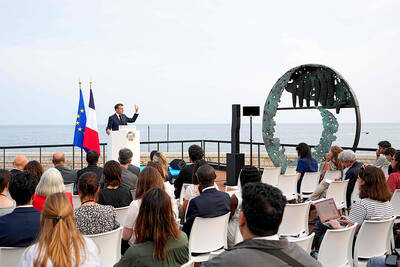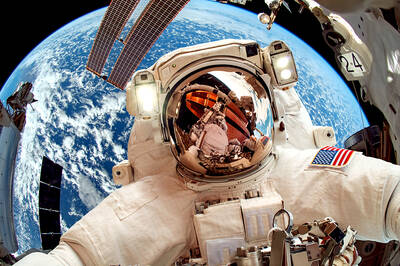Police forced an Indian thief to eat dozens of bananas. They wanted him to excrete a gold necklace he had swallowed.
Sheikh Mohsin, 36, grabbed the 45,000-rupee (NT$37,000) necklace from a woman in Kolkata as she shopped for toys on August 4.
He said he didn't steal the necklace, but a stomach X-ray proved otherwise. Police made him eat bananas in hopes of getting the necklace.

PHOTO: EPA
At first Mohsin wouldn't dine on his banana feast. When police threatened to cut open his stomach, he began eating.
After 50 bananas, police still didn't have their hands on the necklace. So they fed Mohsin a big meal of rice, chicken and bread.
He finally excreted the necklace on his fifth attempt.
A cleaner was paid 50 rupees (NT$41) to fish out the necklace. Mohsin was then asked to wash it.
Police said Mohsin may face three months in jail for stealing.
警方逼迫一名印度小偷吃下好幾打香蕉,要他把吞下的一條金項鍊給排出來。
三十六歲的席克•莫辛在八月四日,搶了一位女士價值四萬五千印度盧比(約新台幣三萬七千元)的項鍊,當時她正在加爾各答買玩具。
他堅稱沒偷項鍊,但胃部X光片證明了事實正好相反。所以警方才叫他吃香蕉,希望能拿到項鍊。
一開始莫辛還不肯吃他的香蕉大餐,當警方威脅要剖開他的肚子時才開始吃。
但他吃完五十根香蕉後,警方還是沒得到項鍊。所以又餵他吃了一頓大餐,有米飯、雞、和麵包。
他終於在嘗試第五次時將項鍊排出。
一名清潔工受雇以五十盧比的代價(約新台幣四十一元)把項鍊給撈起來,莫辛則被叫去清洗項鍊。
警方說莫辛可能因偷竊而須坐牢三個月。(翻譯:張愛弟)

William I of Prussia, a passionate painter, often autographed his works with “tormentis pinxit” — “painted in pain” — as a nod to his struggles with gout. Other historical figures like King Henry VIII of England and Benjamin Franklin also suffered from this “disease of kings,” which was common among people indulging in luxurious diets. Gout is primarily caused by high levels of uric acid in the body. Uric acid forms as the body breaks down purines, which are found in foods like red meat and seafood. Normally, the kidneys filter out uric acid. However, if the body produces

The UN Ocean Conference wrapped up in Nice, France on Friday last week with world leaders taking major steps toward marine protection and vowing a showdown when nations meet to negotiate rules for deep-sea mining next month. But a lack of funding pledges and the total omission of fossil fuels disappointed some observers. The summit was just the third — and largest yet — dedicated entirely to what the United Nations calls an “emergency” in the world’s oceans. The High Seas Treaty, or Global Ocean Treaty, is also known as the Agreement under the United Nations Convention on the Law

Some 400 kilometers above the Earth’s surface, the “International Space Station” (ISS) operates as both a home and office for astronauts living and working in space. Astronauts typically stay aboard the station for up to six months and engage in groundbreaking research projects in various fields, such as biology, physics and astronomy. These projects help scientists understand life in space and contribute to advancements that benefit people on Earth. The ISS has experienced significant growth since construction began in 1998. The station’s design and assembly represent an extraordinary international collaboration among Canada, the European Union, Japan, Russia and the United States.

Continued from yesterday(延續自昨日) https://www.taipeitimes.com/News/lang Living on the ISS is challenging due to the absence of gravity. Astronauts must strap themselves into sleeping bags to prevent floating away while they sleep. They also spend about two hours exercising daily using specialized equipment. Despite this, microgravity can cause muscle loss, bone density reduction and cardiovascular changes. As a result, astronauts require extensive rehabilitation upon their return to Earth. In spite of these difficulties, astronauts often describe their experience on the ISS as life-changing. One of the most awe-inspiring aspects of living aboard the space station is the unparalleled view of Earth. Traveling at